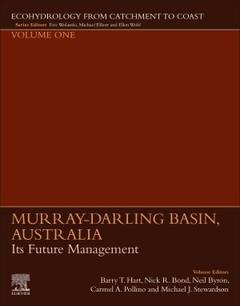Murray-Darling Basin, Australia Its Future Management Ecohydrology from Catchment to Coast Series
Coordonnateurs : Hart Barry, Byron Neil, Bond Nick, Pollino Carmel, Stewardson Michael

Murray-Darling Basin, Australia: Its Future Management is a much-needed text for water resources managers, water, catchment, estuarine and coastal scientists, and aquatic ecologists. The book first provides a summary of the Murray-Darling River system: its hydrology, water-related ecological assets, land uses (particularly irrigation), and its rural and regional communities; and management within the Basin, including catchments and natural resources, water resources, irrigation, environment, and monitoring and evaluation. Additionally, the recent major water reforms in the Basin are discussed, with a focus particularly on the development and implementation of the Basin Plan.
Murray-Darling Basin, Australia: Its Future Management then provides an analysis of the next set of policy and institutional reforms (environmental, social, cultural and economic) needed to ensure the Basin is managed as an integrated system (including its water resources, catchment and estuary) capable of adapting to future changes. Six major challenges facing the Basin are identified and discussed, particularly within the context of predicted changes to the climate leading to an increased frequency of drought and a hotter and dryer future. Finally, a ?road map? or ?blueprint? to achieve more integrated management of the Basin is provided, together with some ?key lessons? of relevance to others involved in the management of multijurisdictional river Basins.
1. Introduction to the Murray–Darling Basin system, Australia Barry T. Hart, Nick R. Bond, Neil Byron, Carmel A. Pollino, and Michael J. Stewardson
Section 1: Rural communities and water-related assets 2. Rural and regional communities of the Murray–Darling Basin Carmel A. Pollino, Barry T. Hart, Martin Nolan, Neil Byron, and Rod Marsh 3. Hydrology of the Murray–Darling Basin Michael J. Stewardson, Glen Walker, and Matthew Coleman 4. Water-based assets of the Murray–Darling Basin and their ecological condition Nick R. Bond, Shane Brooks, Samantha Capon, Jennifer Hale, Mark Kennard, and Heather McGinness 5. Ecological condition of the Lower Lakes and Coorong Justin Brookes, Kane Aldridge, Matthew Hipsey, Brendan Busch, Qifeng Ye, Matt Gibbs, and David Paton 6. Water quality: Land use impacts on salinity, sediments, and nutrients Glen Walker and Ian P. Prosser 7. Water quality in the Murray–Darling Basin: The potential impacts of climate change Darren S. Baldwin
Section 2: Policy and management of the MDB 8. Current water resources policy and planning in the Murray–Darling Basin Megan Dyson 9. Current integrated catchment management policy and management settings in the Murray–Darling Basin John Riddiford 10. Active management of environmental water in the Murray–Darling Basin Hilary Johnson, Michael Peat, and Jody Swirepik 11. Monitoring, evaluation, and adaptive management in the Murray–Darling Basin Ben Gawne, Katie A. Ryan, Matthew Coleman, Alex Meehan, Peter E. Davies, Adam Sluggett, Andy Lowes, Neville Crossman, and Colin Mues
Section 3: Climate change impacts in the MDB 12. Climate change in the Murray–Darling Basin Penny Whetton and Francis Chiew 13. Adaptation and policy responses to climate change impacts in the Murray–Darling Basin Anthony (Tony) Slatyer
Section 4: Policy and management responses to other future challenges 14. Future environmental water management Andrew K. Sharpe, Darren S. Baldwin, Fiona Dyer, and Iwona Conlan 15. Empowering First Nations in the governance and management of the Murray–Darling Basin Sue Jackson, Rene Woods, and Fred Hooper 16. Challenges to improved integrated management of the Murray–Darling Basin Rebecca Nelson 17. The role of future science and technologies in water management Chantal Donnelly, Leo Lymburner, Ulrike Bende-Michl, Andrew Frost, and Eva Rodriguez 18. The way forward: Continuing policy and management reforms in the Murray–Darling basin Barry T. Hart, Jason Alexandra, Nick R. Bond, Neil Byron, Rod Marsh, Carmel A. Pollino, and Michael J. Stewardson
Academics,
Water, catchment, estuarine and coastal policy people,
Irrigation companies,
Environmental water managers,
International water policy and management personnel
Dr Neil Byron was the Commissioner responsible for environment, agriculture and natural resource management issues in the Productivity Commission from April 1998 to March 2010. He presided over twenty-six public inquiries and directed the PC's environmental economics program. Since 2008, he has been an Adjunct Professor in Environmental Economics at the ANU then at the University of Canberra. In 2014/15 he chaired an independent review of Biodiversity Legislation in NSW which led to the drafting of a new Biodiversity Conservation Act. Neil is a Fellow of the Australian Institute of Company Directors. From 2008 to 2011 he was a non-executive Director of a plantation forestry company in New Zealand an
- Provides a consolidated account of the Murray-Darling Basin system; an area of global relevance to those interested in rebalancing river systems where the water resources have been over allocated
- Offers a detailed analysis of the current system and its management, with a focus on water and ecosystem management
- Discusses a number of key challenges, particularly those related to climate change, facing future reforms to the Murray-Darling Basin Plan
- Provides a blueprint for changes needed to ensure the Basin is managed as an integrated whole (from catchment to coast)
Date de parution : 10-2020
Ouvrage de 470 p.
19x23.3 cm
